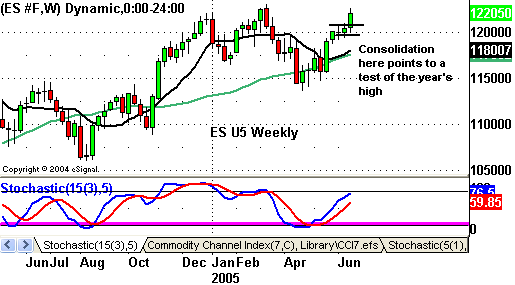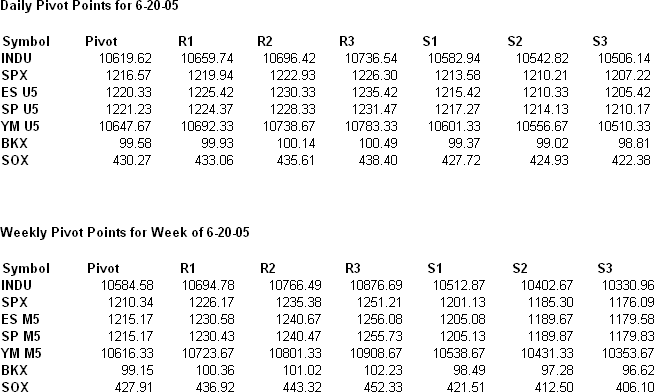The Real Estate Factor: What Happens When Housing Slows Down?
The major indexes were able to post respectable gains for
the week, despite there not really being any standout session to the
upside. Instead, stocks advanced in a modest fashion each day. The leading
sectors were Energy, Retail and Biotech shares. It was even more impressive
that the gains took place against a backdrop that saw commodity prices surge
(i.e. inflationary pressures are mounting). Breadth was firmly positive, which
allowed the broad SP 500 to finish at its highest level since early March and
into positive territory for the year.
The June
SP 500 futures closed out the week with a gain of +16.50 points, while the Dow
futures posted a smaller relative gain of +99 points. On a weekly basis, the ES
and YM both continue to form the right shoulder of a Head & Shoulders pattern,
but have a ways to go to break the neckline. It seems like both contracts
worked off their recent moves up by biding time, rather than correcting.Â
Looking at the daily charts, the ES gapped through its December high and posted
a shooting star, leaving new resistance at the year’s high, while the YM posted
a big gravestone above its 62% Fib retracement of this year’s slide. For you
daily 3-Line Break followers, the ES remains long with a new Break Price of
1210, while the YM is also long with a new Break Price of 10588.
                   
If there’s
any surprise so far this year, it’s been the economy’s resilience in the face of
continued rate hikes. Not only do commodity prices continue to hold their own,
but so does lending and consumer discretionary spending. If I had to pinpoint
the reason for this continued strength it would be housing. Because of the
continued above-average appreciation of homes, the “wealth effect” of the late
1990’s appears to be back. This time, the wealth effect is likely more
profound, given that 70% of the adult population in the U.S. owns a home.
One would
have thought that 8 rate hikes by the Fed would have slowed housing by now.Â
However, long rates have actually declined from the time the Fed started raising
rates 1 year ago. Also, despite the 8 rate hikes, the Fed Funds Rate still
remains below historical norms. More to the point, short-term rates are also
still below the rate of inflation, which discourages saving. This, in turn, has
sent a tremendous amount of excess liquidity into the housing sector. Lenders
are using their creative financing programs such as “negative amortization
loans” where the principle balance actually increases each month. It’s probably
safe to say that some of the recent gains in housing have been artificial, but
that also doesn’t necessarily mean the party is about to end for housing. On
the contrary, there have been few, if any, signs of a slowdown at this point,
despite what a lot of the talking heads have said. Nevertheless, because of the
creative financing and artificially low interest rates stimulating housing, it’s
very likely that we’ll see problems down the road for the economy and the stock
market, should real estate slow down. Â

Please feel free to email me with any questions
you might have, and have a great trading week!
Â
Â
Â
Â
